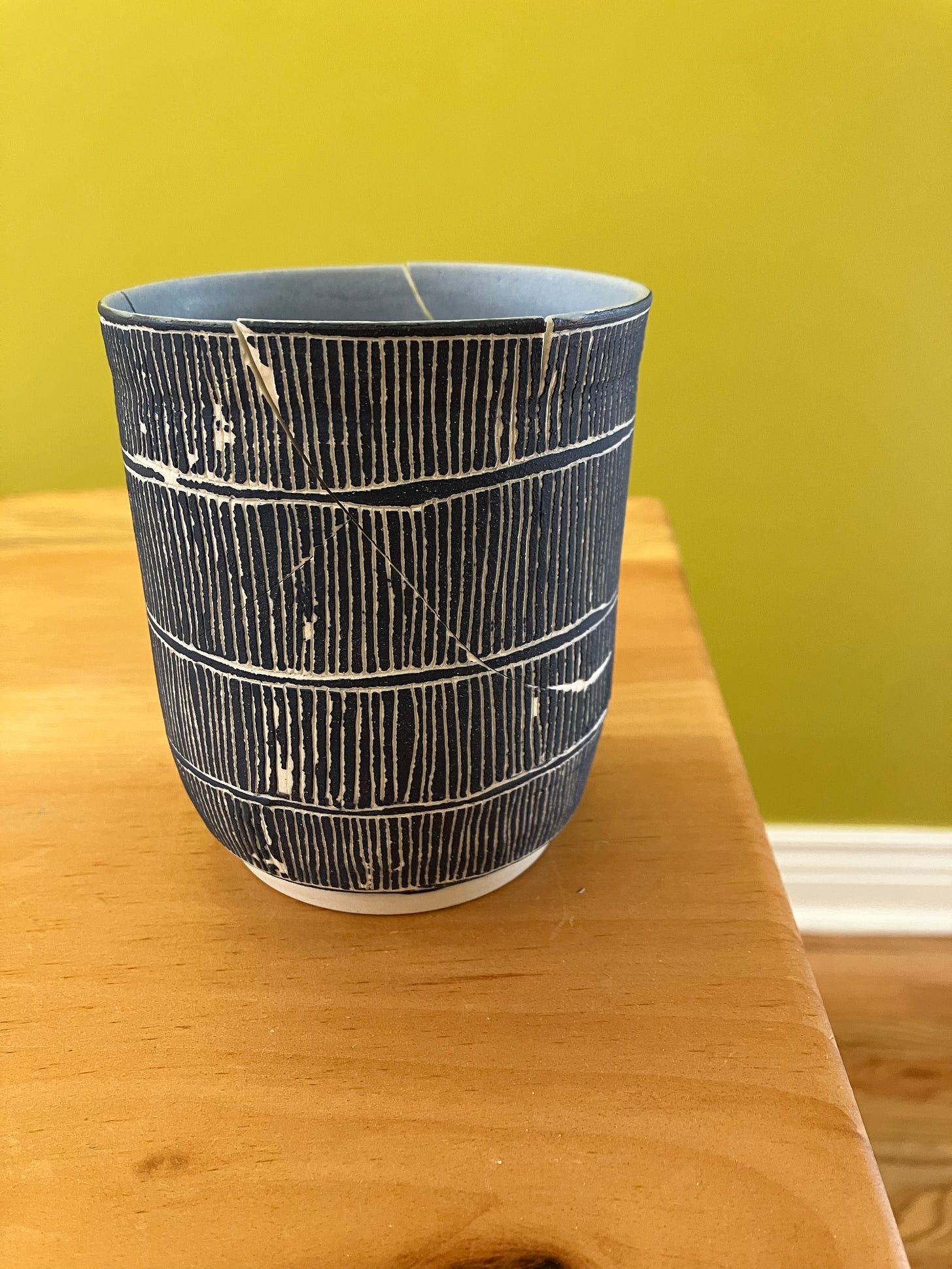Lately, I’ve been running into a bunch of glazing problems. The specific gravity is off on my cone 6 (2232° F) celadon, so it doesn’t move the way I want; I keep having to flocculate or deflocculate depending on the day. The glaze in the bucket is very old, and a part of me wonders if it’s still good, especially lately. My matte blue that looks beautiful in the gas kiln at cone 9 (2336° F) causes explosions and won’t adhere to the clay body in the electric kiln.
I know, I know. This is a niche post. Or at least it seems that way. A very quick lesson on glaze chemistry: in an electric kiln, which I have in our basement, running on a dishwasher circuit, the glaze firing takes place in an oxidation environment—there’s lots of oxygen inside the kiln during the firing process. The opposite—reduction—happens when you deprive the atmosphere of oxygen. I love reduction firings. You need a gas kiln to do it, and although I’ve had access to the gas kiln at the community college this summer, I haven’t done much with it, instead firing lots of small cups and tests inside my little electric kiln. What this means, mostly, is that I need to stop trying to make fetch happen. I keep putting glazes destined for the gas kiln into my little electric and hoping things will work out. Inevitably, they don’t, even when I make chemical corrections for the change in reaction and temperature.
This summer, I have mostly created tiny shards of glass in the bottom of my kiln I then vacuum with our shop vac, in lieu of the 500 finished pots I wanted to make. There’s still a month left. I could make it, and I may. But I’m struggling to get the glazing chemistry to work. In the meantime, the price of lithium has gone up dramatically. Lithium is a flux at mid-temperature glazes, used to bring down the melting point of other chemicals. It makes gorgeous, glossy pots, especially in waterfall glazing—glazes that have one color on top but then break with a different color underneath. It’s a pretty cool phenomenon. But lithium is crazy expensive now, so all the potters I know are redoing their glaze recipes to use a different flux instead (generally a type of feldspar). I still have a handful of glazes from before, and I tell myself I want to use them, especially since they’re so rare now. I keep joking that I need to write a grant for a bag of lithium (now $3,000 for fifty pounds). Whatever actually makes it out of the kiln I want to throw out immediately. Everything is hideous. When I make pots that shatter in the kiln, I want to throw out these too.
But what does all of this have to do with writing? The writing is also sort of like the glazing. I am making words, and some of the words are useful, but a lot of them are probably less useful. Will any of these end up in the book? Maybe. I’ve found that I don’t have great perspective when it comes to the writing itself. That when I’m in the work, I hate everything. The act of writing is horrible, and somehow, it keeps happening. I’m trying not to judge it. There are different ways to accomplish this: to have daily word count goals, or weekly goals. Some people cover the screen while they write. I have writing zoom dates with friends. We announce what we’re doing, then mute and work for an hour or two or three. Sometimes one of us has to get up and get more coffee. Sometimes one of us has to cut things short because of an appointment or a meeting. Sometimes we write for an hour and it’s not enough so we have to write for another hour. I don’t know if the words will all end up in the book. But right now I don’t need to worry. Worrying about the work is almost above my pay grade, honestly. I’m just here to make the pages and see what happens next. When I don’t know where to go, I start a new section, or a new word document, and then start again. If I want to delete something, and it’s longer than a line, I put it in another word document I keep open on the side, like scraps. Sometimes the scraps get pasted back into the section I’m working on. Sometimes not. But they’re there, just in case I need them.
My husband keeps digging my broken pots out of the trash. He says I should kintsugi things together instead. I could glaze things back together with gold, an ancient Japanese technique. Traditionally, it’s made with gold and lacquer, or resin. So, maybe I’ll do that, or else try to refire some of these pieces at a low temperature, with low-temp glazes that won’t expand much. I’ll try not to hate the work I’ve ruined. Maybe it just needs a little gold instead.




Absolutely delightful read! The chemistry is far beyond me, love your authenticity. I've got a little pottery experience and a little life experience and I totally resonated the expectation of 500 beautiful, finished pieces, only to be met with shards! Wonderfully resonant. Also love the basement electric-kiln-on-the-dishwasher-circuit macgyver. Subscribed!
I like this comparison! Glazing and writing. 💕